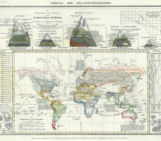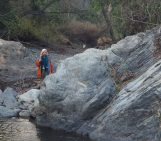
Yin and Harrison (2000) puts together an exhaustive review of three decades of geological and geophysical investigations on the Himalayan-Tibetan orogen. This research supports the orogenesis started during the Cenozoic between 70 and 50 Ma ago as a consequence of the Indo-Asian collision following the closure of the Tethys ocean between Laurasia and Gondwana.
Yin and Harrison (2000) underlines the importance of investigating the pre-Cenozoic geologic framework in order to fully understand the evolution of the Himalayan-tibetan orogen. A complete view of the Paleozoic and Mesozoic tectonic structures and the associated metamorphic igneous and sedimentary evolution for each orogenic unit (e.g., Lhasa Terrane, Fig. 1) is presented. The strength of the article lies in its detailed review of the various geological data (rocks and structures) used as foundation of the models that are discussed in the last part of the article.
Since the Himalayan-Tibetan orogen is considered one of the best places to study continent-continent collision, the authors discuss the arguments used to constrain the timing of the initial India-Asia collision including: 1) palaeomagnetism and plate kinematics, which seemed to support a change in velocity between India and Eurasia at ca. 50 Ma; 2) stratigraphy and palaeontology, which show a switch from marine to terrestrial environment of deposits, interpreted as the youngest age for collision at ca. 52 Ma; 3) shortening of the passive margins between 66 and 55 Ma. In conclusion, these data bring to ca. 70 Ma as the start of the India and Asia collision.

Fig 1. From Yin and Harrison (2000), N-S to NE-SW trending simplified geological cross-section across the Himalayan-Tibetan orogen.
The syn- to post-collisional deformation accommodated along the famous Main Central Thrust (MCT) and the South Tibetan Detachment System (STDS) are discussed in combination with thickness (several km locally), displacement (140 to 500 km) and polyphased evolution of the deformation zone. The Late Cenozoic rift systems across the Himalayas-Tibet are also described and all alternative modes (oblique convergence, eastward expansion of the Tibetan plateau) are discussed, including the well-known model of Tapponnier.
After a complete overview of the Cenozoic geological settings the authors conclude the article with a very useful summary of their conclusions. In particular, they affirmed that: 1) the Cenozoic deformation brought to a north-south shortening of at least 1400 km, expressed in the surface by the presence of thrust belts and distributed shortening that involved basement rocks; 2) the crustal shortening led to the construction of the Tibetan plateau between the northern Qilian and the northern margin of the Indian continent; 3) pre-Cenozoic tectonics strongly controlled the Himalayan-Tibetan orogeny, including the petrogenesis distribution; 4) portions of the continental crust were subducted beneath Tibet.
The role of strike-slip faults (with several hundred of km of displacement) in forming the arcuate shape of the orogenic system is discussed and would be still worth investigating, especially in the arcuate syntaxes not discussed in the article. Deep imaging now available from geophysical surveys has also had a great impact because it can visualize at depth, the major faults and features discussed in the article, notably regarding the deep characteristics of the shallow structures (MCT and STDS) and their relation to partial melting zones (e.g. Nelson, 1992).
Magmatism is a weak argument to estimate the time of continent/continent collision, given the wide age span between 120 and 30 Ma (see references in Yin and Harrison, 2000). The careful review in the article of the syn-collisional magmatic systems, essentially the leucogranites (not pre-collisional such as the Kohistan arc), is anyway useful. Various models can explain source-rock partial melting: tectonically-driven -i.e., burial- heat, shear heating, role of radioactive heat production and fluids. Issues with decompressional melting are still debated mechanisms but only robust observations as the one reported in the article can contribute to the debate.
Last but not least the geological evolution of the Himalayan-Tibetan orogen is considered of importance for climate as well. Research has found evidence about the impact of the Himalayan-Tibetan evolution on global climate changes already at the time of the publication (e.g., Ruddiman & Kutzbach 1989; Quade et al., 1995) but the work is still in progress.
Written by Marta Marchegiano, Benoît Petri, Gianluca Frasca and the TS Must Read team
References
Yin A and Harrison TM (2000) Geologic evolution of the Himalayan-Tibetan Orogen. Annu. Rev. Earth Planet Sci., Vol.28, pp. 211-280
Ruddiman WF and Kutzbach JE. (1989) Forcing of Late Cenozoic northern hemisphere climate by plateau uplift in southern Asia and the American west. J. Geophys. Res. Vol.94, 18409–27
Quade J, Cater JLM, Ojha TP, Adam J and Harrison TM (1995) Late Miocene environmental change in Nepal and the northern Indian subcontinent: stable isotope evidence from paleosols. Geol. Soc. Am. Bull., Vol.107, pp. 1381– 97
Nelson K.D. (1992) Are crustal thickness variations in old mountain belts like the Appalachians a consequence of lithospheric delamination? Geology, Vol. 20, pp. 498–502.



